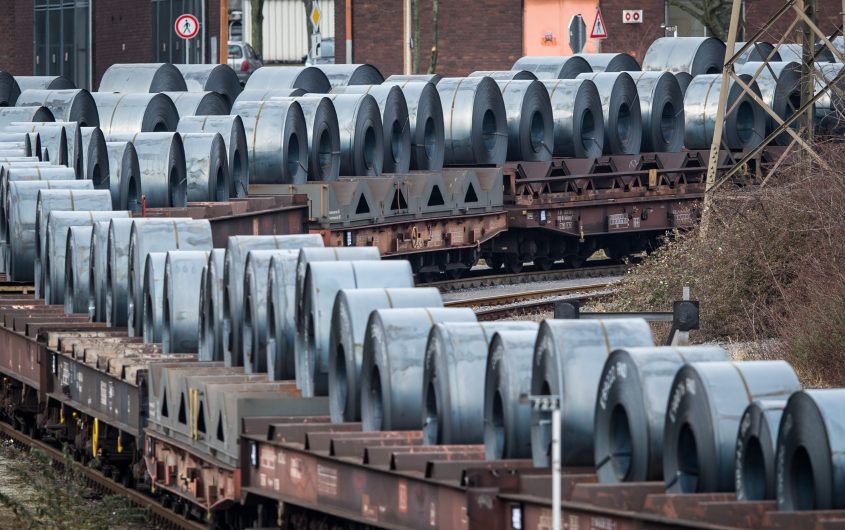
Lukas Schulze/Getty Images
The Transatlantic Trade Drama Enters Act III

Peter S. Rashish
Vice President; Director, Geoeconomics Program
Peter S. Rashish, who counts over 30 years of experience counseling corporations, think tanks, foundations, and international organizations on transatlantic trade and economic strategy, is Vice President and Director of the Geoeconomics Program at AICGS. He also writes The Wider Atlantic blog.
Mr. Rashish has served as Vice President for Europe and Eurasia at the U.S. Chamber of Commerce, where he spearheaded the Chamber’s advocacy ahead of the launch of the Transatlantic Trade and Investment Partnership. Previously, Mr. Rashish was a Senior Advisor for Europe at McLarty Associates, Executive Vice President of the European Institute, and a staff member and consultant at the International Energy Agency, the World Bank, UN Trade and Development, the Atlantic Council, the Bertelsmann Foundation, and the German Marshall Fund.
Mr. Rashish has testified before the House Financial Services Subcommittee on International Monetary Policy and Trade and the House Foreign Affairs Subcommittee on Europe and Eurasia and has advised three U.S. presidential campaigns. He has been a featured speaker at the Munich Security Conference, the Aspen Ideas Festival, and the European Forum Alpbach and is a member of the Board of Directors of the Jean Monnet Institute in Paris and a Senior Advisor to the European Policy Centre in Brussels. His commentaries have been published in The New York Times, the Financial Times, The Wall Street Journal, Foreign Policy, and The National Interest, and he has appeared on PBS, CNBC, CNN, NPR, and the BBC.
He earned a BA from Harvard College and an MPhil in international relations from Oxford University. He speaks French, German, Italian, and Spanish.
The drama over steel and aluminum tariffs is now entering its third act. The plot lines have become clear, and the possible denouements are emerging. But it remains to be seen if this will be a story of submission, war, or comity.
To recap, in the first act that began on March 1, President Trump announced duties of 25 percent on imported steel and 15 percent on imported aluminum in order to protect U.S. national security. The NAFTA partners of the U.S.—Canada and Mexico—would be exempt while the renegotiation of that trade pact was continuing.
The second act opened on March 22, when the White House decided to exempt additional like-minded trading partners until May 1: the European Union, Argentina, Brazil, Australia, and Korea. The Koreans proceeded to strike a deal, agreeing among other things to a quota on its steel exports to the U.S.
Act III began just last week when the administration announced a final, one-month extension of the exemptions until June 1. There have been reports that Argentina and Brazil have also settled—accepting quota arrangements, but ones more favorable than the Korean terms—and that a deal with Australia is also in the works.
That leaves the European Union as the main protagonist, along with the United States.
For the next few weeks the action in Act III will be centered on transatlantic bargaining. White House trade adviser Peter Navarro has announced that by the June 1 date all countries will have to accept one of two things: application of the 15 and 25 percent tariffs, or a quota arrangement to limit their exports to U.S. markets.
One thing is clear: the EU will not submit its steel exports to a U.S. quota, both because it is convinced (rightly) that they pose no threat to U.S. national security, and because such a move would violate WTO rules.
That means Act IV could be consumed with a trade war: the U.S. imposes the tariffs, and the EU strikes back with a group of counter-tariffs that it has already announced would include politically sensitive items like bourbon from Kentucky (home of Senate Majority Leader Mitch McConnell) and Harley-Davidson motorcycles from Wisconsin (House Speaker Paul Ryan’s home state).
If history is any guide, Act V would ultimately lead to a resolution of the conflict, with both sides pulling back from their tariffs, but not before creating considerable economic casualties in both the U.S. and the EU and political bad blood between the two. A tale “full of sound and fury, signifying nothing.”
There is an alternative story line that could be written. For that to happen, the U.S. and the EU would both need a dose of realism in their trade policy. They would have to recognize they are indispensable for each other’s global economic success. And they would need to understand they are both economic superpowers equally and justifiably determined to defend their interests as they see them—interests that overlap to an overwhelming extent.
With this awareness, Act IV of the drama could instead feature the U.S. and the EU agreeing to negotiate a trade agreement, which could start with a commitment to reduce or even eliminate the tariff barriers between them. Since at least 40 percent of U.S.-EU trade is between the same companies’ operations on either of the Atlantic, such a step would immediately improve the competitiveness of American and European companies globally.
With confidence restored, Act V could then feature the next phase of negotiations: new trade rules to cover state-owned enterprises, electronic commerce, technology transfer, intellectual property, labor and environmental protections, and the role of small- and medium-sized companies in global trade. Such rules, which are nearly absent in the World Trade Organization, would help boost fairness in the international trading system.
We will know in a few weeks which of these two narratives will play out on the transatlantic stage.







